
Details Details Details.... Hey, I like technical details too - I'm an Electrical Engineer!
Being frustrated with resets in my Party Zone machine, I dug in and did a detailed system view analysis of the problem. Please read on to better understand my views of the linear 5 Volt supply, the 12 Volt Regulated supply, how my daughterboard changes these systems, and the impacts of these changes.
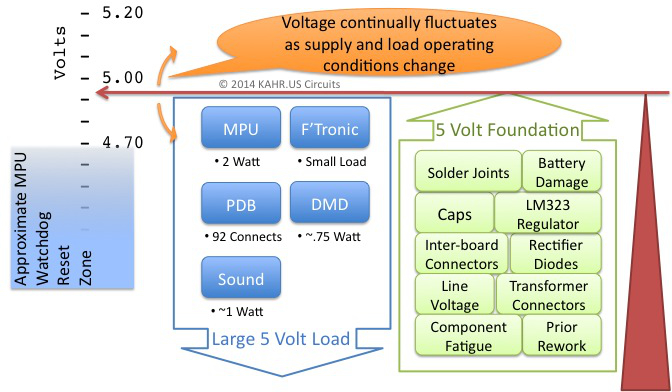 The linear 5 Volt system in WPC machines
The linear 5 Volt system in WPC machines
I've assembled the complicated picture to the right to detail my analysis of the linear 5 Volt supply on the Power Driver Board (PDB). At a high level it depicts how the condition of the 5 Volt supply's pieces and the various loads drawing from the supply interact to create the system voltage measured at the test point.
The load on the power supply (depicted in blue) spans multiple boards and multiple functions on those boards. The linear 5 Volt supply provides Vcc for many CMOS and TTL chips. It drives signal lines via pull-up resistors. It biases transistors. I measured the 5Volt load of the MPU board, DMD, and the sound board empirically via current measurements to determine individual board power use. I tabulated over 90 PDB connection points to the linear 5 Volt supply. I don't have a fliptronics board so I reviewed the schematic to determine it likely draws a small load compared to the other boards. Additionally the linear 5 Volt supply can be passed to the backbox and playfield via PDB jumpers J117 to J119. There is A LOT of demand on the linear 5 Volt power supply.
Anyone who has read about or worked to solve reset problems recognizes the many sources for weakness in the supply itself - what I call the foundation of the 5 Volt supply. Best maintenance practices are well documented in this realm and I'm not looking to discredit any of those maintenance strategies. Indeed you will need a functioning linear 5 Volt supply in your WPC pinball whether or not you install my daughterboard. Taking a system view, however, there are a myriad of permutations that weaken the overall ability to drive 5 Volts from the supply. Worse, issues that may not alone frequently drop voltage levels to trigger resets are additive so a combination of problems within the foundation and/or the load may contribute to the reset. And nothing is static in real-world operations. Power draws change through the cycle of a game; environmentals such as temperature fluctuate. Reminds me of one tough Soduku!
All of this means there is going to be some variability in the 5 Volt supply and at some point those variations will trigger resets via the watchdog circuit on the MPU board. Now, the watchdog is part of the design of the MPU board to protect the most sensitive electronics in the machine by means of a graceful computer shutdown. It serves a valid purpose and should not be disabled. Its board (the MPU board), however, should be offered the cleanest power signal possible... I set out to do exactly that.
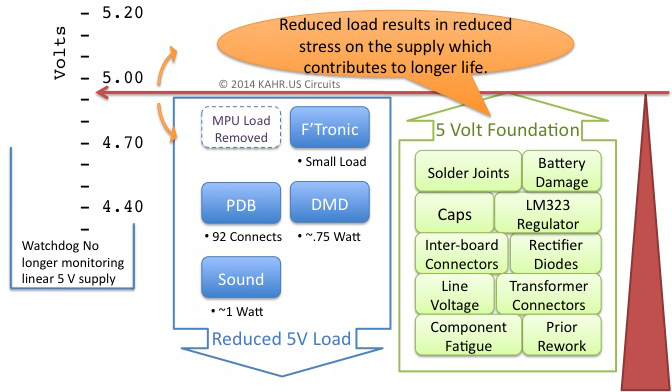 The daughterboard changes the power balance for the WPC linear 5 Volt supply
The daughterboard changes the power balance for the WPC linear 5 Volt supply
As shown in the diagram to the left, the daughterboard literally removes the MPU from the PDB linear 5 Volt supply. All of the functions on the MPU are instead driven by a new, switching regulator supply included on the daughterboard. The watchdog circuit, as a 5 Volt function on the MPU continues to serve it's role of protecting the ASIC, the processor, and the PROM chips by monitoring the new switching supply. Because (1) the new supply develops a very reliable, clean, temperature tolerant voltage and (2) the MPU load when isolated is more static, the watchdog is no longer driven to reset for off-MPU board fluctuations. Further, the reduced loading on the linear 5 Volt supply allows for more tolerance to imperfections in the foundations of the supply. Again, the linear supply needs to be maintained but it now has more capacity or "give".
The daughterboard moves the MPU load to the 12V regulated PDB supply so that circuit deserves some investigation as well...
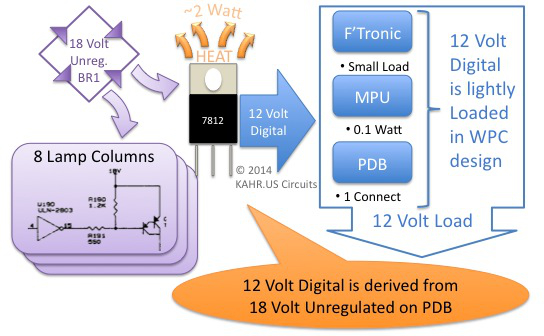 Analysis of the linear 12 Volt system in WPC machines
Analysis of the linear 12 Volt system in WPC machines
Two 12 Volt supplies exist on the PDB - an unregulated and a regulated (or digital) 12 Volt supply. Focus here is solely on the regulated supply because my daughterboard design moves the MPU power load to the regulated 12 Volt supply. The entire 12 Volt regulated supply is itself a load on the 18 Volt unregulated supply formed through BR1 and C6/C7 on the PDB. In addition to powering the 12 Volt regulated supply, the 18 Volt supply also drives the lamp column circuits on the PDB.
The 12 Volt digital is created by passing the 18 Volts through a LM7812 linear voltage regulator. The LM7812 has been used in countless circuits to do exactly what it does in the WPC design - provide a stable 12 volt supply for loads up to about 1 amp. As with any linear supply the LM7812 burns off excess power as heat as a byproduct of creating the stable supply line. In WPC the load on the 12 Volt regulated supply is well below the LM7812 design spec - it biases one chip and burns one indicator LED on the PDB, it biases a couple chips on the MPU which combined draw less than 0.1 Watt, and it biases two LM339s on the Fliptronic board. In short, the LM7812 has the spare capacity needed to drive the additional MPU load moved here by my daughterboard.
As with the linear 5 Volt supply, the 18 Volt supply and 12 Volt digital supply must be maintained. If it is nonfunctional it needs corrected.
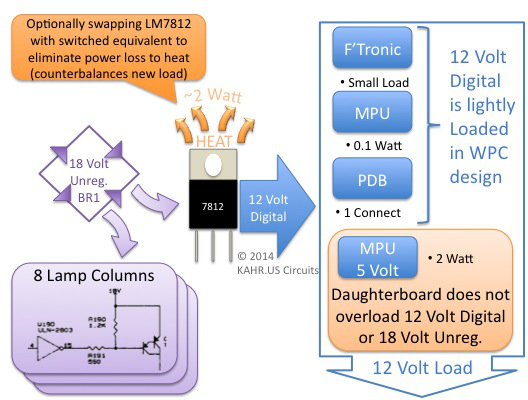 How the daughterboard changes the power balance for the linear 12 Volt system in WPC machines
How the daughterboard changes the power balance for the linear 12 Volt system in WPC machines
Finally, this graphic shows the 12 Volt regulated supply loaded with the daughterboard-provided 5 volt MPU supply. The switching regulator on the daughterboard pulls the 2 Watts of power required to drive the MPU board from the 12 Volt supply described above. At 12 Volts, the 2 Watt load is 0.17 Amp and my measurements of the daughterboard installed in my Party Zone confirm this calculated load. Because the 12 Volt regulated supply is lightly loaded in the WPC design, the LM7812 can deliver this additional power without issue. To confirm it, I measured the temperature of the 7812's heat sink without and then with the daughterboard installed. Ambient room temperature was 62 degrees F; without the daughterboard the heat sink was at 84 degrees after one hour of machine play... with the daughterboard the heat sink was at 96 degrees after one hour of machine play.
But as long as we are tinkering, why not think a little more about the heat loss in the LM7812? Eliminating that heat loss would reduce the 12 Volt regulated supply's power loading on the 18 Volt power supply. The heat load can be significant - in the WPC design where the step-down across the LM7812 is 6 Volts, a 12 Volt load of 0.33 Amp would mean 2 Watts are burned off as heat. 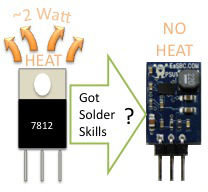 With the addition of the daughterboard that's about the range where the circuit will operate. Without the daughterboard the power lost to heat is lower because the current draw on the LM7812 is lower but it is still measurable wasted power. In any case, swapping the LM7812 for a pin-compatible switching regulator replacement eliminates the heat loss and consequently eliminates the need for the heat sink. From the optic of the 18 Volt supply, the reduction in load is a counterbalance to the load transferred to the 18 Volt supply by installing the daughterboard. For those with soldering skills I suggest making the change; for those lacking confidence in their soldering skill, stick with the LM7812. I made the swap in my Party Zone but left the 7812 in my Bride of Pinbot.
With the addition of the daughterboard that's about the range where the circuit will operate. Without the daughterboard the power lost to heat is lower because the current draw on the LM7812 is lower but it is still measurable wasted power. In any case, swapping the LM7812 for a pin-compatible switching regulator replacement eliminates the heat loss and consequently eliminates the need for the heat sink. From the optic of the 18 Volt supply, the reduction in load is a counterbalance to the load transferred to the 18 Volt supply by installing the daughterboard. For those with soldering skills I suggest making the change; for those lacking confidence in their soldering skill, stick with the LM7812. I made the swap in my Party Zone but left the 7812 in my Bride of Pinbot.
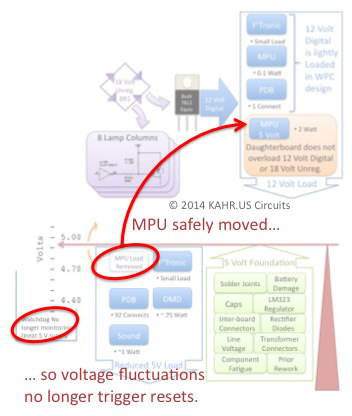 In summary, The MPU's load on the 5V linear supply is removed entirely. The load is transferred to the 12V regulated (aka 12V digital) supply that was much more lightly loaded in WPC designs. The Watchdog circuit on the MPU is still active and will continue to do it's job protecting the MPU's components, but the new switching supply for the MPU is very stable which stops game resets. Although not necessary, the LM7812 regulator on the PDB can be replaced with a switching regulator equivalent that eliminates wasted power (released as heat) from the linear regulator. The reduction in power consumption in the LM7812 counterbalances some of the load inserted by moving the MPU.
In summary, The MPU's load on the 5V linear supply is removed entirely. The load is transferred to the 12V regulated (aka 12V digital) supply that was much more lightly loaded in WPC designs. The Watchdog circuit on the MPU is still active and will continue to do it's job protecting the MPU's components, but the new switching supply for the MPU is very stable which stops game resets. Although not necessary, the LM7812 regulator on the PDB can be replaced with a switching regulator equivalent that eliminates wasted power (released as heat) from the linear regulator. The reduction in power consumption in the LM7812 counterbalances some of the load inserted by moving the MPU.
And, the daughterboard can be removed as easily as it was installed without any modifications to the WPC machine.
The power supplies still need to be maintained, but no longer do we need to fret over every hundredth of a volt. Soduku solved!
Order Yours Today!!!

 The linear 5 Volt system in WPC machines
The linear 5 Volt system in WPC machines The daughterboard changes the power balance for the WPC linear 5 Volt supply
The daughterboard changes the power balance for the WPC linear 5 Volt supply Analysis of the linear 12 Volt system in WPC machines
Analysis of the linear 12 Volt system in WPC machines How the daughterboard changes the power balance for the linear 12 Volt system in WPC machines
How the daughterboard changes the power balance for the linear 12 Volt system in WPC machines With the addition of the daughterboard that's about the range where the circuit will operate. Without the daughterboard the power lost to heat is lower because the current draw on the LM7812 is lower but it is still measurable wasted power. In any case, swapping the LM7812 for a pin-compatible switching regulator replacement eliminates the heat loss and consequently eliminates the need for the heat sink. From the optic of the 18 Volt supply, the reduction in load is a counterbalance to the load transferred to the 18 Volt supply by installing the daughterboard. For those with soldering skills I suggest making the change; for those lacking confidence in their soldering skill, stick with the LM7812. I made the swap in my Party Zone but left the 7812 in my Bride of Pinbot.
With the addition of the daughterboard that's about the range where the circuit will operate. Without the daughterboard the power lost to heat is lower because the current draw on the LM7812 is lower but it is still measurable wasted power. In any case, swapping the LM7812 for a pin-compatible switching regulator replacement eliminates the heat loss and consequently eliminates the need for the heat sink. From the optic of the 18 Volt supply, the reduction in load is a counterbalance to the load transferred to the 18 Volt supply by installing the daughterboard. For those with soldering skills I suggest making the change; for those lacking confidence in their soldering skill, stick with the LM7812. I made the swap in my Party Zone but left the 7812 in my Bride of Pinbot. In summary, The MPU's load on the 5V linear supply is removed entirely. The load is transferred to the 12V regulated (aka 12V digital) supply that was much more lightly loaded in WPC designs. The Watchdog circuit on the MPU is still active and will continue to do it's job protecting the MPU's components, but the new switching supply for the MPU is very stable which stops game resets. Although not necessary, the LM7812 regulator on the PDB can be replaced with a switching regulator equivalent that eliminates wasted power (released as heat) from the linear regulator. The reduction in power consumption in the LM7812 counterbalances some of the load inserted by moving the MPU.
In summary, The MPU's load on the 5V linear supply is removed entirely. The load is transferred to the 12V regulated (aka 12V digital) supply that was much more lightly loaded in WPC designs. The Watchdog circuit on the MPU is still active and will continue to do it's job protecting the MPU's components, but the new switching supply for the MPU is very stable which stops game resets. Although not necessary, the LM7812 regulator on the PDB can be replaced with a switching regulator equivalent that eliminates wasted power (released as heat) from the linear regulator. The reduction in power consumption in the LM7812 counterbalances some of the load inserted by moving the MPU.